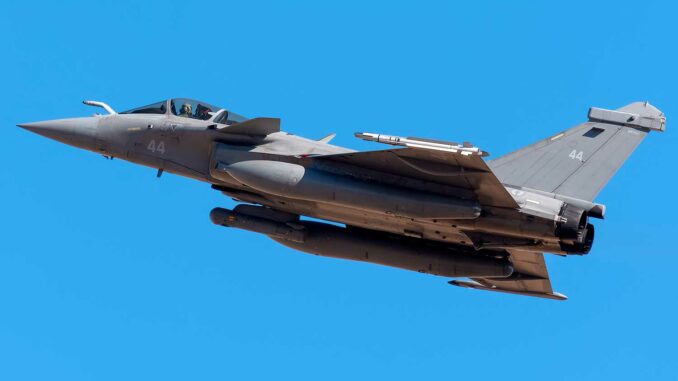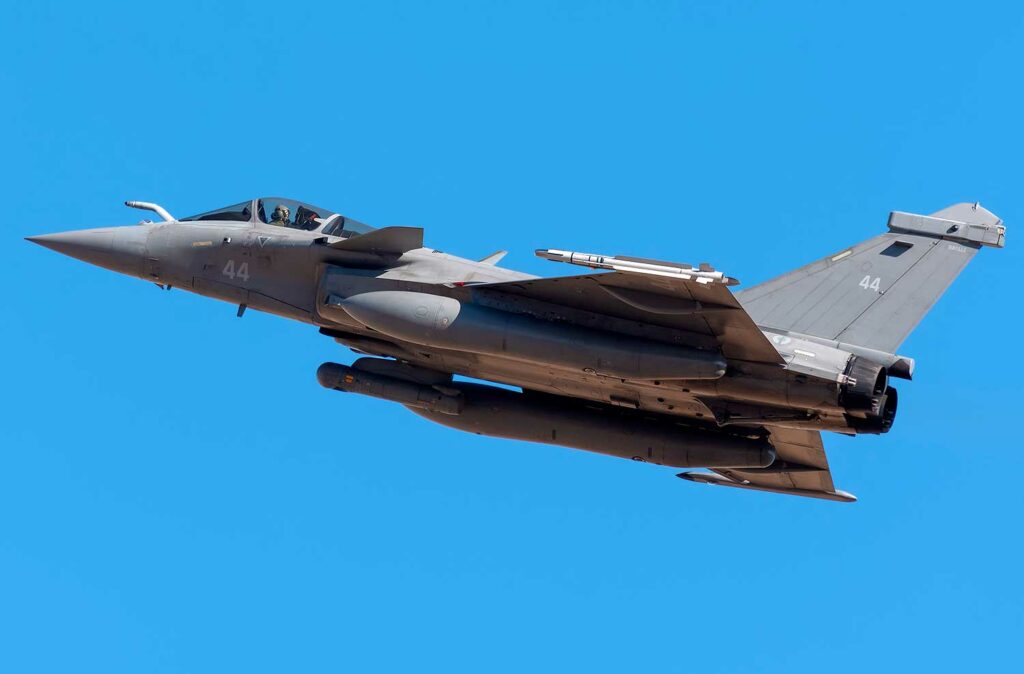
The Rafale owes its superiority to its modular EMTI/MDPU computer, a “plug-and-fight” architecture that combines sensors, speeds up updates, and quickly integrates new weapons.
In summary
The Rafale is based on an integrated avionics architecture known as EMTI/MDPU (Ensemble Modulaire de Traitement de l’Information / Modular Data Processing Unit). This “digital core” distributes the computing load across standardized modules and recognizes connected equipment, much like a USB key in a computer. In concrete terms, the EMTI performs data fusion by aggregating RBE2 AESA radar, optronic sensors, SPECTRA electronic warfare, and data links. This approach reduces the pilot’s workload, improves track quality, and allows functions to be added via software without having to redesign the entire avionics system. Comprising around 20 hot-swappable modules, the system offers significantly greater computing power than previous-generation computers and is key to the scalability of standards (F2, F3, F3R, and F4) standards with the rapid integration of weapons such as Meteor or AASM. Compared to older federated architectures, EMTI reduces integration costs and lead times, is similar to a “plug-and-fight” logic, and places the Rafale at the top of the range of current multirole aircraft.
The principle: modular architecture that centralizes intelligence
The EMTI/MDPU concept
The Rafale breaks with the old logic of dedicated computers and juxtaposition of “black boxes.” It adopts a centralized modular architecture: the EMTI/MDPU. This computer distributes critical functions (mission management, navigation, weapons, sensors, human-machine interface) across standardized modules interconnected by a high-speed data bus. Each module is a replaceable “card” that executes part of the overall software, with the whole forming a fault-tolerant and scalable on-board computer.
From the outset, the goal was to enable automatic recognition of connected equipment: when a new sensor, effector, or weapon variant is added, the system identifies it, loads the software drivers, and exposes the available functions. The analogy with a USB key is relevant: you plug it in, the EMTI detects it, and the aircraft “knows” how to use it.
The technical building block: modules, LRUs, and computing power
The core consists of a set of LRUs (line-replaceable units)—up to 19 in total—most of which (18) are specialized processors. Each delivers significantly more computing power than a previous-generation mission computer. This granularity allows for incremental upgrades: a card can be replaced, memory can be added, and a newer generation of processors can be introduced without having to re-qualify the entire architecture.
In practice, this makes it possible to keep pace with the civilian world (COTS) in terms of microprocessors, while complying with aeronautical constraints: hardening, safety software, temperatures, vibrations. The benefit is twofold: increased performance and controlled life cycle costs.
Software mechanics: data fusion for decision-making
The multi-sensor fusion chain
Data fusion is the EMTI’s flagship function. It aggregates in real time the flows from the RBE2 radar (particularly the AESA active antenna), the front sector optronics (OSF), the IR, the SPECTRA electronics, the alert receivers, the external pods, and the tactical links. The fusion engine correlates detections, calculates a single track per target, estimates a confidence level, and removes duplicates. On the display, the pilot does not explore sensor by sensor; he operates in a consolidated tactical situation, with simplified symbols and clear priorities.
In the aircraft, this consolidation translates into less cognitive “noise,” more stable tracks, and faster engagements. It also provides an essential foundation for advanced functions: multi-target tracking, coordinated BVR engagements, optimized use of jamming and decoys, and intelligent allocation of sensors within a flight.
The human-machine interface and workload
Merging is only valuable if it is readable. The EMTI supports ergonomics designed for efficiency: head-up displays, HUD, HOTAS controls. The pilot obtains consolidated tracks with attributes (type, azimuth, distance, quality), a synthetic situation that allows him to anticipate. The result: reduced workload, better-informed decisions, and temporal superiority during critical phases (detection-identification-fire).
Maintenance and scalability: a “plug-and-fight” approach
Rapid integration of weapons and sensors
Because EMTI decouples hardware and software, integrating a new sensor or weapon is faster. The driver is implemented, the fire control logic and display modes are added, the chain is qualified, and the aircraft is ready to take advantage of the new feature. This is what made it possible to integrate guided munitions from different families and designation pods, and then to support the arrival of an AESA radar without overhauling the rest of the system.
This modularity reduces the time between the decision to integrate and operational deployment. In a context where threats and electronic warfare are evolving rapidly, this speed is strategic: the aircraft remains effective in the face of jamming, modern surface-to-air missiles, and stealth profiles.
Reduced costs and downtime
The modules are replaceable online, which reduces long downtime. Planned maintenance operations are simplified by the reliability of the avionics core and integrated diagnostics. This improves the ratio of maintenance hours per flight hour, with smaller technical teams and less cluttered hangars. For operators, this translates into lower operating costs and higher availability throughout the year.
Comparison: how does the Rafale compare to other aircraft?
Older federated architectures
Previous-generation fighters used a constellation of dedicated computers. Each hardware upgrade required extensive re-qualification, re-wiring, and sometimes compromises in performance due to insufficient bandwidth between “boxes.” The result was long, costly integrations and a more heterogeneous cockpit. The Rafale’s integrated approach corrects these limitations by design.
Contemporary integrated architectures
Modern competing fighters have also migrated to integrated, modular architectures. The idea of concentrating power in a “core processor” and controlling everything via software is now standard. The uniqueness of the Rafale lies in the early maturity of this approach, in the consistency of the EMTI-data fusion combination, and in the consistency of scalability between successive standards. Operationally, this is reflected in the ease of integrating third-party sensors, links, or updated electronic warfare libraries.
The evolution path: from F2 to F4 standards
Introduction and ramp-up
EMTI was associated with the Rafale very early on in the program, with a continuous ramp-up of the F2 and then F3 standards. Subsequent increments (F3R, F4) capitalize on the same architecture by adding software capabilities, fusion optimizations, processing algorithms for new weapons, and enhanced network functions. The key point is the stability of the foundation: the EMTI structure remains the pivot, while the cards and software evolve mechanically.
Concrete use cases
In air-to-air applications, fusion improves the effective range of sensors and situational awareness. In air-to-ground, it correlates laser designations, synthesized coordinates, and tracks from the connected battlefield, accelerating target acquisition and reducing fratricide. For survivability, EMTI orchestrates the entire SPECTRA suite: detection, classification, active and passive countermeasures, decoy management, all integrated into the display to select maneuvers.
The “USB key” metaphor: what it means, precisely
“Plug-and-fight” in a combat aircraft
The comparison with the USB key illustrates the philosophy: standardization of interfaces, automatic detection and initialization, activation of functions without heavy re-engineering. In the aircraft, this implies strict discipline in terms of software layers (drivers, middleware, mission applications) and interface contracts between modules. New equipment is plugged in, the EMTI “sees” it, initializes it, announces its services to the system, and exposes the functions to the pilot via the HMI. Qualification tests then focus on the chain concerned, not the entire aircraft.
Tactical and industrial benefits
Tactically, integration time is reduced, which gives an advantage in terms of adaptability: new ISR pods, new ammunition, and more frequently updated threat libraries. Industrially, hardware-software decoupling creates a more competitive equipment market and facilitates international cooperation: one partner can contribute a sensor, another a software update, both of which fit into the common architecture.

Key figures and benchmarks
Modules and power
The computer comprises up to 19 replaceable modules, 18 of which are high-performance computing units. Each offers increased power compared to previous-generation mission computers, with headroom for resource-intensive processing (multi-target tracking, Kalman filtering, optronic processing, stream compression/decompression).
Measured effects in operation
In the field, we see cleaner screens, fewer redundant objects, consolidated tracks with a displayed confidence level, and less cluttered screens in complex situations. Crews save time with each OODA loop. In maintenance, the modular logic allows for a reduced logistical footprint, with fewer technicians per aircraft and rapid module replacement operations on the line.
The outlook: a foundation ready for embedded AI
Next steps
The continuous increase in card power paves the way for more automatic triage algorithms, emission classification, decision support, and low-signature target detection. Multi-source fusion will become more “semantic,” with finer correlations and dynamic priorities depending on the mission. EMTI remains the solid foundation for absorbing these building blocks without changing the architecture.
The challenge of sovereignty and exports
By retaining control of the architecture and relying on an ecosystem of suppliers with expertise in maps and software, the aircraft maintains its digital sovereignty. This is an asset for exports: functions can be adapted and specific integration hooks can be opened without affecting the certified core. Customers get a customizable aircraft without losing system consistency.
The driving force
The Rafale owes its operational agility to an architectural choice: entrusting intelligence to a single modular computer capable of recognizing equipment, merging sensors, and updating itself quickly. This choice reduces integration costs, accelerates modernization cycles, and ensures the aircraft’s long-term relevance in a sky saturated with emissions, data links, and adaptive threats. As long as the pace of card and software development remains steady, the EMTI/MDPU will continue to act as the true “USB key” of combat aviation.
Sources
Dassault Aviation – Rafale file (PDF): description of the MDPU, LRUs, and scalability.
Dassault Aviation – Synthesize and facilitate: the EMTI/MDPU, data fusion, and scalability.
Dassault Aviation – Rafale press kit (PDF): role of the EMTI, fusion principles, and confidence levels.
Thales – On board the Rafale: MDPU/EMTI and multi-sensor fusion.
Omnirole-Rafale (summary site): introduction of the EMTI to the F2 standard, 19 modules and relative power.
Dassault Aviation – Exploit and support: maintenance, logistical footprint and availability.
ArmyRecognition – Rafale fact sheet: IMA and central role of the MDPU (summary).
Portail-Aviation – Summary article: modularity of the MDPU/EMTI and evolution logic.
WarWingsDaily – Rafale MSDF and sensor/link integration (educational summary).
War Wings Daily is an independant magazine.